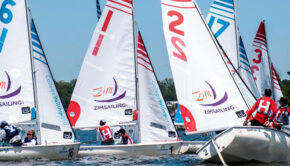Good to be a Sailing Bear
Published on May 31st, 2020
The Brown University sailing team has grown to become one of the powerhouses in college sailing, with the Bear’s women’s team as the top ranked squad in the final vote of the 2019-2020 school year.
As one of eight private universities in the Ivy League collegiate athletic conference, they are among some of the most prestigious universities in the world, and while they are on the low end of the financial endowment range, they still got bank.
Located in Providence, Rhode Island, Brown’s sailing exploits have earned them cred in the school administration, and while having had only club status among other varsity sailing programs, they are now benefiting from a new initiative to reshape and improve competitiveness in Brown varsity and club athletics.
Significantly, while 11 Brown varsity teams will transition to club status, the Brown club coed sailing and club women’s sailing will each transition to varsity status — a reflection of the advantages of Brown’s location and facilities for sailing as well as a long history of competitive success.
The initiative aligns with the University’s diversity and inclusion efforts, expanding opportunities for non-recruited athletes to participate in competitive club sports and enhancing diversity on teams, which already attract a diverse array of student-athletes.
The difference between club and varsity teams is significant in regard to funding, academic, and athletic support.
Brown will cease training, competition and operations at the varsity level for men’s and women’s fencing; men’s and women’s golf; women’s skiing; men’s and women’s squash; women’s equestrian; and men’s track, field and cross country (which are three varsity sports under federal Title IX rules governing access to opportunities in sports).
Gender equity was among the most essential criteria for decision-making for the revised lineup of teams. The initiative supports Brown’s strong commitment to providing equal opportunities to women and men in varsity athletics and compliance with federal Title IX, which governs access to opportunities in athletics.
The revised roster of teams was determined through a thorough, data-driven review that assessed such factors as the existing strengths of each team; current roster sizes; and the quality of facilities available for practice and competition.
For example, the committee considered that Rhode Island does not have mountains to support a strong program in skiing, yet the state has one of the best sailing bays in the country and a new sailing facility.
Brown is currently home to the third-largest number of varsity teams in the nation. Almost 900 students competed across Brown’s 38 varsity teams last year, including non-recruited athletes invited to “walk on” to complete rosters. In the decade ending in 2018, Brown earned 2.8% of Ivy League titles, the lowest among member schools. The initiative will implement a net reduction in varsity teams from 38 to 29.









 We’ll keep your information safe.
We’ll keep your information safe.